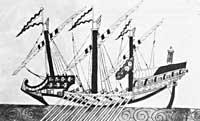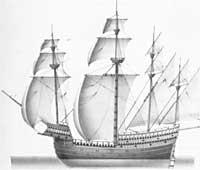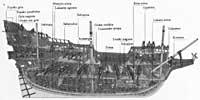History of Naval Industry VI: a life in losses
Elhuyar Fundazioa

XIV. and XV. Life on 19th century ships was very hard. For the sailors there was a hard discipline. The food was bad and scarce. On the other hand, they had to row constantly.
The loss was the most common ship of the time and from there emerged the fusta, the galleon, the bergantina and the smallest frigate. They all rowed and had one or several masts to place the candles.
The loss was 40 or 50 meters long and 6 or 7 meters wide. Ancient in form and IX. From the nineteenth century he sailed by the sea.
The whip was smaller and lighter. It was only thirty meters long and five meters wide. However, he had more rowing than loss. The shaft had 18 to 22 oars on each side and losses from 14 to 20. The frigate was the smallest ship. It had between 6 and 12 oars per side and often without masts.
The Venetians used more galeilas. It was a giant ship. It was 70 meters long. 16 meters wide. He was endowed with three great masts and was covered. Inside it had twenty-three eaves on either side. Behind it was a large and tall bridge.
As the galleaza was full of cannons, it dominated the sea. He carried about three hundred men, of whom two hundred were rowers. In addition to rowers, commander, officers, NCOs, counterweights, pilots, helmsmen, cook, shipyards, etc. they used to go. The soldiers depended on a captain who was at the command of the ship commander.
Not all rowers were condemned by justice. XIV. and XV. For centuries, rowers came to galleys voluntarily. These volunteer rowers had permission to have mustache and long hair. However, penados had no burrs or hair on their heads.
Free rowers were allowed to talk and walk during the day when they had no rowing shift. But at night, like the prisoners who joined them in chains.
And let's start with the description of the same loss. On the deck, in stern, the boat had no rowing, and this was the noblest corner. One room occupied almost the entire stern and this room only corresponded to the captains. In the stern, on the other hand, was the castle and on it soldiers with cannons. About the bow castle, candles, anchors, etc. were handled.
Between the castles of bow and stern, on the oars were corridors to the left and right, where they walked back and forth both sailors and ship officers.
In the stern, under cover, was the captain's room, surrounded by officer cabins. Beyond the bow was the shipowner. Next to him, the pantry. There they kept the cecina, the cheeses, etc. Flour, bread, rice and beans were stored in another basement.
On the bow were toilets and basements for candles, laces and tools. In Branka the NCOs slept.

The sailors had two pounds bisquilla, a pound of meat, a cecina liberdi, a cheese liberdi, a pint of wine and a little oil. The officers also had other foods.
The ship's cleaning status was unfortunate. The sailors, in no case had the consideration of pride to wash and if by swimming they would not wash with water. In addition, they had no more than clothing and it is to be expected the abundance of lice.
However, the prisoners were ordered to be hairless and clean. But as they couldn't get out of the tar during the day, the dirt also dominated around them, even though the boat presented a clean look through paint flags and colors.






